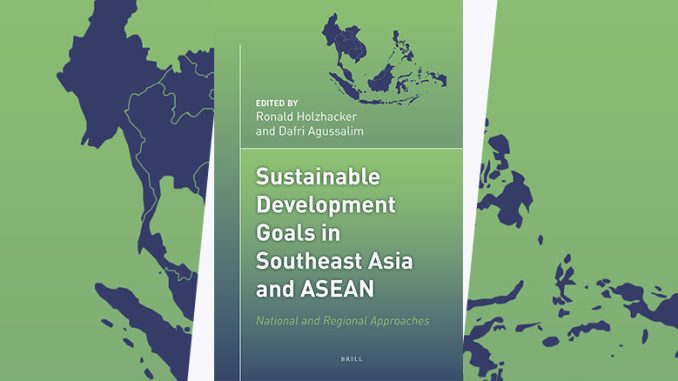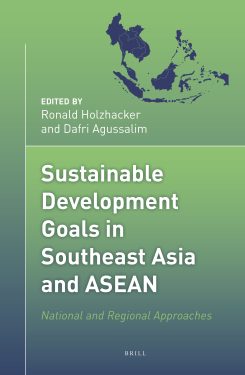
Sustainable Development in Southeast Asia and ASEAN – National and Regional Approaches
Ronald Hohlzacker and Dafri Agussalim (Eds.)
Brill, 2019
Compiling an edited volume, particularly one that emanates from research papers presented and discussed at academic conferences is both a challenge and an opportunity for the editors. The challenge of bringing together multiple perspectives spanning different academic disciplines and approaches did not deter Ronald Hohlzacker and Dafri Agussalim, the editors of Sustainable Development in Southeast Asia and ASEAN, however. They seized this challenge as an opportunity to discuss how countries in Southeast Asia would meet their commitments for accomplishing the United Nations Sustainable Development Goals (SDGs) individually and collectively. The resulting seven-section, seventeen-chapter book is probably the first academic attempt to present a research-based assessment of the priority SDG focus for each of the Southeast Asian countries represented or discussed in the book. As such, it presents a complementary, high-resolution reading to the several country and regional policy reports generated by international and regional organisations, while at the same time drawing from the data compiled by such reports. Yet, the book aims at “moving the discussion away from the exclusive domain of the UN and national policy makers”.
Sustainable Development in Southeast Asia and ASEAN had its origins in not one but two research conferences in 2017; the introduction by Ronald Hohlzacker describes this as a “convergence of the academic agendas of European and Southeast Asia research institutions around the SDGs”. Chapter authors also had the opportunity to discuss their findings and recommendations at a policy conference in 2018, where they could engage the different policy communities in the European Union (EU) and the Association of Southeast Asian Nations (ASEAN). Hohlzacker explains from the outset the editors’ objective to share “scholarly work related to the SDGs … with a wide range of government officials, policy makers, civil society organizations, and other scholars”.
The contributors to the book hail from various academic and research backgrounds, with a shared interest in regional affairs and international relations as it relates to their countries and the region. They were all encouraged to apply the various lens of their research expertise in considering how SDG implementation will be pursued locally, nationally and regionally. Thus, the book’s title includes both Southeast Asia as the region and ASEAN as the regional mechanism coordinating implementation efforts.
 The book is divided into seven thematic parts: ‘Institutions and Governance for the Sustainable Development Goals’; ‘Accountability to Citizens and Human Rights to Ensure Progress toward the SDGs’; ‘SDGs and Progress on the Social Agenda in Middle-Income and Developing Countries in Southeast Asia’; ‘SDGs and the New Urban Agenda, Cities, and Transport’; ‘SDGs and the Environment, Clean Air and Water for All’; ‘SDGs and the Economic Agenda for Inclusive Economic Growth and Decent Work for All’; and ‘SDGs, Agriculture, and Community Development through Partnerships’.
The book is divided into seven thematic parts: ‘Institutions and Governance for the Sustainable Development Goals’; ‘Accountability to Citizens and Human Rights to Ensure Progress toward the SDGs’; ‘SDGs and Progress on the Social Agenda in Middle-Income and Developing Countries in Southeast Asia’; ‘SDGs and the New Urban Agenda, Cities, and Transport’; ‘SDGs and the Environment, Clean Air and Water for All’; ‘SDGs and the Economic Agenda for Inclusive Economic Growth and Decent Work for All’; and ‘SDGs, Agriculture, and Community Development through Partnerships’.
Each Southeast Asian country’s SDG ‘challenge’ reflects the authors’ view of the priority areas for political will and action from both within the country and its external partners. The discussions also give a glimpse into the political and socio-economic issues and tensions that seize national governments’ attention. For example, providing adequate housing and shelter is a continuing priority for Brunei through the decades, and in Myanmar the Rohingya issue has become a “grave reputational problem” for the country’s interactions with the international community.
The introduction chapter provides the best starting point to tackle this compendium, as it explains the editor’s vision and approach, and gives useful background and review of the SDG (policy) literature and chapter summaries. Reading the introduction chapter will give neophytes and experts alike an important overview of the interconnectedness of the national, regional and international contexts for SDG implementation, and introduce another important element to the SDG discourse: the ‘from below’ inputs of civil society and/or grassroots communities.
This book demonstrates the diverse scope of research and the voices of Southeast Asian researchers on issues and implications related to the SDGs. A comprehensive list of references accompanies each chapter (with one exception). An index is invaluable for such a compendium, as it helps the reader locate specific topics and issues within the seventeen chapters.
Most of the chapter authors have affiliations to academic institutions and entities studying ASEAN and its relations with international partners and organisations. Interestingly, the chapter on Myanmar and the SDGs is authored by Thuta Aung, a businessman-researcher. The various chapters present a largely national outlook for SDG implementation, albeit discussing the potential merits and entry points for international collaboration. Consistent with the thematic approach highlighted in the introduction chapter, the chapters discuss governance and human rights/security issues, and civil society inputs to policy.
Three out of the book’s seventeen chapters consider an ASEAN or regional comparative assessment: Helena Varkkey’s discussion of ‘Transboundary haze, ASEAN and the SDGs: Normative and Structural Considerations’; Azira Hashim and Aliyyah Nuha Faiquah Azman Firdaus’ co-authored chapter on ‘Sustainable Development Goals and Capacity Building in Higher Education in Malaysia and ASEAN’, and Julio C. Teehankee’s comparative assessment of four Southeast Asian countries in discussing ‘Accountability Challenges to Sustainable Development Goals in Southeast Asia’. Three others mention ASEAN mechanisms and/or policy frameworks in relation to the topics they discuss: ‘Human Rights and Sustainable Development Goals: the Philippines in the Postnational’ by Ulrich Karl Rotthoff; ‘Legal Protection of Construction Workers and the Right to Safe Working Conditions: Lessons from Cambodia’ by Kimsan Soy; and ‘Bluewashing, Green Coffee, and the Sustainable Development Agenda in Southeast Asia’ by Amador IV Peleo and Titus C. Chen.
Reading this book, I recall my own efforts to bring about a sharing of views and voices – albeit among policy officials – in 2005, on the challenges that each ASEAN member state faced in implementing the Millennium Development Goals (MDGs) which were the precursor to the SDGs. I therefore gave a closer reading to those chapters that related to ASEAN’s role in connecting different interests within and across countries and communities. Varkkey’s realistic discussion of the ASEAN Way norms identifies the limitations of what the introduction mentions as ‘ASEAN’s involvement as a regional actor’. The concluding sentence of the Hashim-Firdaus co-authored chapter on ‘Sustainable Development Goals and Capacity Building in Higher Education in Malaysia and ASEAN’ also indicates where the communication gaps lie in each national context. They call for “[a] clear understanding of the connections and interactions between the SDGs” in developing “future actions and policies for the nation and the region”.
An important feature of this book is the absence of a separate conclusion chapter. Instead, Hohlzacker includes a conclusion section in the introduction chapter, where he puts forward six findings as recommendations. The common strand running through these suggestions also link the book’s chapters: inclusivity, and the responsibility to implement.
Reviewed by Moe Thuzar
Moe Thuzar is a Fellow at the ISEAS-Yusof Ishak Institute, and 2019-20 Fox International Fellow at Yale University.
